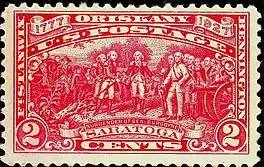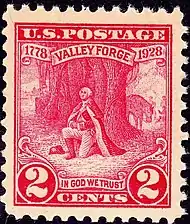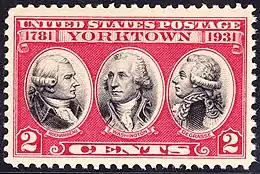Commemoration of the American Revolution
Commemoration of the American Revolution typifies the patriotic sentiment surrounding the American Revolution and the desire to preserve and honor the "Spirit of '76". As the founding story of the United States, it is covered in the schools, memorialized by a national holiday, and commemorated in innumerable monuments. Thus Independence Day (the "Fourth of July") is a major national holiday celebrated annually. Besides local sites such as Bunker Hill, one of the first national pilgrimages for memorial tourists was Mount Vernon, George Washington's estate, which attracted ten thousand visitors a year by the 1850s.[1]
Memory
Every nation constructs and honors the memory of its founding, and following generations use it to establish its identity and define patriotism.[2] The memory of the Founding and the Revolution has long been used as a political weapon. For example, the right-wing "Tea Party movement" of the 21st century explicitly memorialized the Boston Tea Party as a protest against intrusive government.[3] In the 1850s, editors and orators both North and South claimed their region was the true custodian of the legacy of 1776, as they used the Revolution symbolically in their rhetoric.[4] David Ryan, noting that the Bicentennial was celebrated a year after the United States' humiliating 1975 withdrawal from Vietnam, says the Ford administration stressed the themes of renewal and rebirth based on a restoration of traditional values, and presented a nostalgic approach to 1776 that made it seem eternally young and fresh.[5]
The Revolution became the main source of the non-denominational "American civil religion" that has shaped patriotism, and the memory and meaning of the nation's birth ever since. Specific battles are not central (as they are for the Civil War) but rather certain events and people have been celebrated as icons of certain virtues (or vices). The American Revolution is remembered for its Moses-like leader (George Washington),[6] its prophets (Thomas Jefferson, Thomas Paine), disciples (Alexander Hamilton, James Madison) and martyrs (Boston Massacre, Crispus Attucks, Nathan Hale), as well as its devils (Benedict Arnold), holy sites (Valley Forge, Bunker Hill), rituals (Boston Tea Party), holy symbol (the new flag), sacred holidays (Independence Day), and holy scriptures whose every sentence is carefully studied and applied (The Declaration of Independence, the Constitution and the Bill of Rights).[7]
Great Men
There are innumerable monuments or commemorations of the major Founding Fathers, with the names of Washington and Jefferson (and Lincoln) most often selected for buildings, sculptures, postage, and currency.[8][9] In the 1920s, Washington and Jefferson, together with Theodore Roosevelt and Abraham Lincoln, were chosen by sculptor Gutzon Borglum and approved by President Calvin Coolidge to be the four American heroes celebrated at the Mount Rushmore National Memorial. Over the decades the interpretive framework used by the National Park Service to explain this commemoration has changed, with such themes as localism giving way to nationalism, and overpowering gigantic images of Great Men giving way a little to increased attention paid to the ordinary workers who built it. The visit became less a patriotic pilgrimage than a family-oriented tourist event with success measured in terms of attendance at the remote South Dakota site, which reached a million visitors a year in 1959, and passed the two million level in 2005.[10]
Sites and battlefields
Today, more than 100 battlefields and historic sites of the American Revolution are protected and maintained by federal, state and local governments. The National Park Service, a federal agency, alone owns and maintains more than 50 battlefield parks and sites related to the Revolution.[11] On Veteran's Day (November 11) in 2014, the Civil War Trust, the Society of the Cincinnati and other preservation groups announced the creation of "Campaign 1776," an initiative to protect and interpret the battlefields of the American Revolution and the War of 1812. As does the Civil War Trust, "Campaign 1776" uses public-private partnerships to provide the funding to acquire battlefield properties.[12] By the end of 2017, "Campaign 1776" had acquired more than 675 battlefield acres at 10 battlefields of the Revolutionary War or War of 1812 in six states.[13] On May 8, 2018, the organization became the American Battlefield Trust comprised two divisions, the Civil War Trust and the Revolutionary War Trust.[14]
Bicentennial of 1976
The United States Bicentennial was a series of celebrations and observances during the mid-1970s that paid tribute to historical events leading up to the creation of the United States of America as an independent republic. It was a central event in the memory of the American Revolution. The Bicentennial culminated on Sunday, July 4, 1976, with the 200th anniversary of the adoption of the Declaration of Independence.[15]
Commemorations of the Revolutionary War
After the first U.S. postage stamp was issued in 1849 the U.S. Post Office frequently issued commemorative stamps celebrating the various events of the Revolutionary War.
 issue of 1927 |
 |
 issue of 1931 |
 |
See also: Postage stamps and postal history of the United States
Fiction, film, popular culture
A Canadian specialist on the Revolutionary era has evaluated the evidence, the accuracy and the historical themes employed by twelve Hollywood films featuring the American Revolution from 1939-2002. She covers the major characters, heroes and villains, Patriots and Loyalists, plots, and social and class themes. She compares cinematic understandings of the Revolution with the interpretations of historians to reveal thematic consistencies, variations, and conceptual gulfs between filmmakers and historians.[16][17]
Organizations
- Daughters of the American Revolution, a congressionally chartered organization founded in 1890; its members are female descendants of soldiers or others of the Revolutionary period who aided the cause of American independence.
- Daughters of the Cincinnati, a hereditary organization founded in 1894, and composed of women who are direct descendants of officers of the Continental Army or Navy who served in the Revolutionary War.
- Children of the American Revolution, a congressionally chartered organization founded 1895 (now the nation's oldest and largest patriotic youth organization); membership is open to anyone under the age of 22 who is a direct descendant of someone who served in the Continental Army or gave material aid to the cause of freedom in the American Revolution.[18]
- Society of the Cincinnati, A hereditary society founded in 1783, and composed of men who are male-line descendants of officers of the Continental Army or Navy who served in the Revolutionary War.
- Sons of the American Revolution, a congressionally chartered organization founded in 1889; its members are men who are direct descendants of persons who served in the Revolutionary War or who contributed to establishing the independence of the United States.
- Sons of the Revolution, a hereditary society founded in 1876, and composed of men who are direct descendants of persons who served in served as a military, naval, or marine officer, soldier, sailor or marine, or as a member of the Continental Congress or who assisted in the establishment of American independence in various other ways.
References
- Jean B. Lee, "Historical Memory, Sectional Strife, and the American Mecca: Mount Vernon, 1783-1853," Virginia Magazine of History and Biography (2001) 109#3 pp. 255-300 in JSTOR
- Barry Schwartz, "The social context of commemoration: A study in collective memory." Social forces 61.2 (1982): 374-402. online
- Jill Lepore, The Whites Of Their Eyes: The Tea Party's Revolution and the Battle Over American History (Princeton University Press, 2010).
- Jonathan B. Crider, "De Bow's Revolution: The Memory of the American Revolution in the Politics of the Sectional Crisis, 1850-1861," American Nineteenth Century History (2009) 10#3 pp 317–332
- David Ryan, "Re-enacting Independence through Nostalgia - The 1976 US Bicentennial after the Vietnam War," Forum for Inter-American Research (2012) 5#3 pp 26–48.
- Robert P. Hay, "George Washington: American Moses," American Quarterly (1969) 21#4 pp 780-91 in JSTOR
- Catherine L. Albanese, Sons of the Fathers: The Civil Religion of the American Revolution (1977)
- Lawrence S. Kaplan, Thomas Jefferson: Westward the Course of Empire (1999) p. 1.
- Ian Randal Strock (2008). The Presidential Book of Lists: From Most to Least, Elected to Rejected, Worst to Cursed. Random House. pp. 228–34.
- Teresa Bergman, "Can Patriotism Be Carved in Stone? A Critical Analysis of Mt. Rushmore's Orientation Films" Rhetoric and Public Affairs (2008) 11#1 pp. 89-112 online
- National Park Service Revolutionary War Sites. Accessed Jan. 4, 2018.
- See Campaign 1776 Announced Accessed Jan. 4, 2018.
- See Civil War Trust "Saved Land" webpage. Archived 2017-11-25 at the Wayback Machine Accessed Jan. 4, 2018.
- American Battlefield Trust May 8, 2018 announcement, "National historic preservation ground forms American Battlefield Trust." Accessed May 30, 2018.
- Christopher Capozzola, "'It Makes You Want to Believe in the Country': Celebrating the Bicentennial in the Age of Limits" in Beth Bailey & David Farber, eds., America in the 70s (2004) pp 29-45.
- Nancy L. Rhoden, "Patriots, Villains, and the Quest for Liberty: How American Film has Depicted the American Revolution." Canadian Review of American Studies 37.2 (2007): 205-238.
- Hugh T. Harrington. "Top 10 Revolutionary War Movies" Journal of the American Revolution (Jan. 25 2013) online
- "About N.S.C.A.R." nscar.org. Washington, D.C.: National Society of the Children of the American Revolution. Retrieved April 29, 2019.
Further reading
- Albanese, Catherine L. Sons of the Fathers: The Civil Religion of the American Revolution (1977)
- Butterfield, Emily Lewis. " The Patriot Blood of Our Fathers Runs Through Our Veins!": Revolutionary Heritage Rhetoric and the American Woman's Rights Movement, 1848-1890." (PhD dissertation, Arizona State University, 2016.) online
- Capozzola, Christopher. "'It Makes You Want to Believe in the Country': Celebrating the Bicentennial in the Age of Limits" in Beth Bailey & David Farber, eds., America in the 70s (2004) pp 29–45.
- Gordon, Tammy S. The Spirit of 1976: Commerce, Community, and the Politics of Commemoration. Amherst, MA: University of Massachusetts Press, 2013.
- Hall, Simon. "'Guerrilla Theater...in the Guise of Red, White, and Blue Bunting': The People's Bicentennial Commission and the Politics of (Un-) Americanism." Journal of American Studies (2016): 1-23. online
- Kammen, Michael. A Season of Youth: The American Revolution and the Historical Imagination (1978)
- Linenthal, Edward Tabor. Sacred Ground: Americans and Their Battlefields (U of Illinois Press, 1991)
- McDonnell, Michael A. et al. eds. Remembering the Revolution: Memory, History, and Nation Making from Independence to the Civil War (2013) excerpt
- Purcell, Sarah J. Sealed with Blood: War, Sacrifice, and Memory in Revolutionary America (2002).
- Resch, John. Suffering Soldiers: Revolutionary War Veterans, Moral Sentiment, and Political Culture in the Early Republic (1999).
- Rubin, Anne Sarah. "Seventy-Six and Sixty-One: Confederates Remember the American Revolution." In Where These Memories Grow: History, Memory, and Southern Identity edited by W. Fitzhugh Brundage, (U of North Carolina Press, 2000) pp 85–105.
- Schwartz, Barry. "The social context of commemoration: A study in collective memory." Social forces 61.2 (1982): 374-402. online
Films and TV, popular culture
- Glancy, Mark. "The war of independence in feature films: The Patriot (2000) and the 'special relationship' between Hollywood and Britain." Historical Journal of Film, Radio and Television 25.4 (2005): 523-545.
- Harrington. Hugh T. "Top 10 Revolutionary War Movies" Journal of the American Revolution (Jan. 25 2013) online
- Hume, Janice. Popular Media and the American Revolution: Shaping Collective Memory (Routledge, 2013).
- Murray, Lawrence L. "Feature Films and the American Revolution: A Bicentennial Reappraisal." Film & History 5.3 (1975): 1-6.
- Rhoden, Nancy L. "Patriots, Villains, and the Quest for Liberty: How American Film has Depicted the American Revolution." Canadian Review of American Studies 37.2 (2007): 205-238.
- Schocket, Andrew M. "The American Revolution Rebooted: Hamilton and Genre in Contemporary Culture." Journal of the Early Republic 37#2 (2017): 263-269.
- Taxel, Joes. "The American Revolution in Children's Fiction: An Analysis of Historical Meaning and Narrative Structure," Curriculum Inquiry 14#1 (Spring 1984), 7–55
